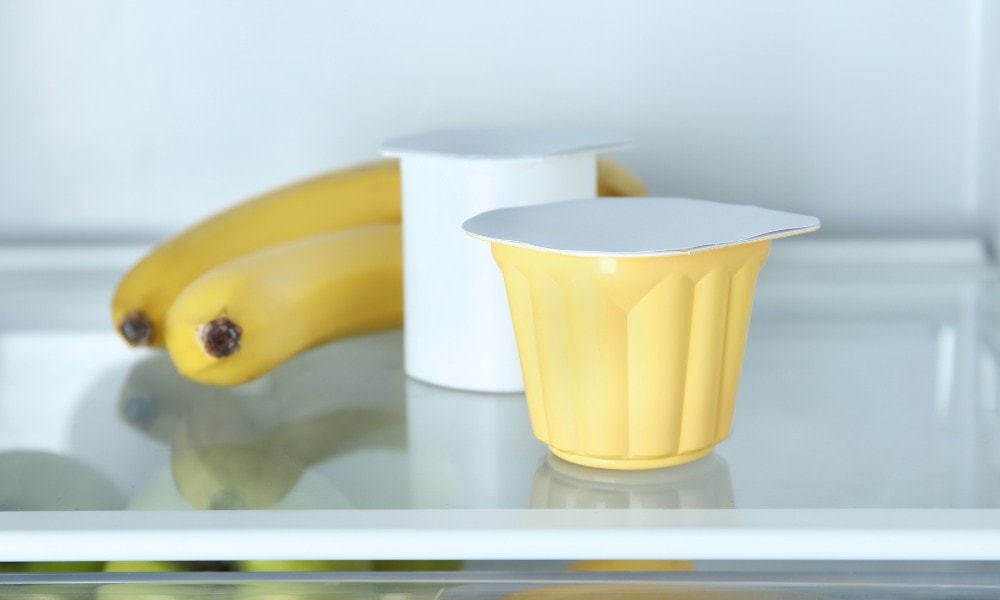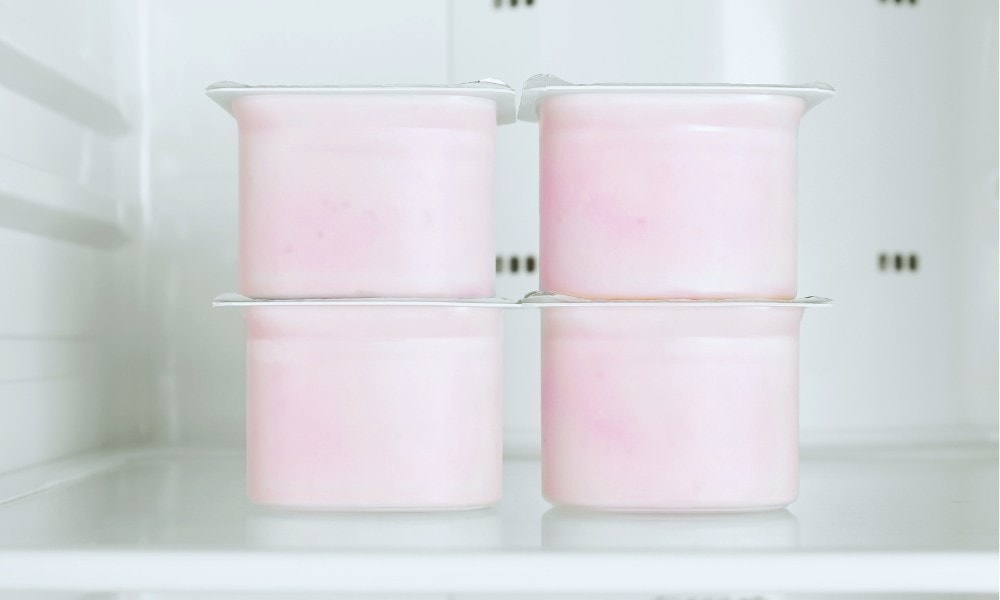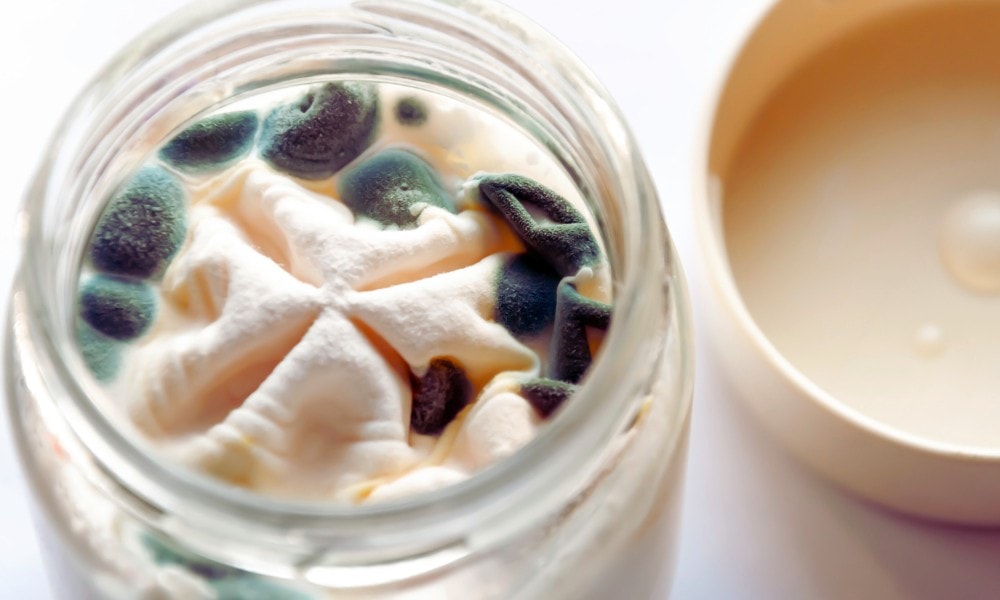Yogurt is a ‘must buy’ item on my grocery list – but sometimes shopping can take a while. Watching a container of yogurt sweat in my shopping cart on a hot day prompted me to ask the question – how long can yogurt sit out for?
To The Point: How Long Can Yogurt Sit Out?
According to the CDC, unrefrigerated yogurt can sit out for 2 hours at temperatures up to 90 °F (32 °C). At higher temperatures, you need to reduce the time it sits out. At temperatures over 90 °F, yogurt can sit out for up to one hour before it starts to spoil.
Now that we know the answer to the main question of this article, let’s also discuss these questions:
Does Greek Yogurt Need to Be Refrigerated?
Greek yogurt is thicker and creamier than regular yogurt, since the whey is strained out in the manufacturing process. It has a more tart flavor for the same reason. But the rules for letting greek yogurt sit out are no different: a maximum of 2 hours.
All yogurts need to be refrigerated. Natural plain yogurts, fruit blend yogurts, Greek yogurt, and yogurt drinks should all be kept between 33°F – 40°F.

However some may spoil faster than others when out of the fridge. Yogurts with fruit mixed in generally have a higher sugar content which may accelerate the spoilage rate. These should definitely not be left out for more than 2 hours! While sugar is a natural preservative when it replaces water in a food substance, it also feeds bacteria, which can speed up the rate of spoilage in a watery food like yogurt.
Yogurt may also spoil faster when contaminated by a dirty spoon.
These rules also apply to other fermented dairy products like buttermilk and sour cream. Kefir – a yogurt drink made from the milk from cows, goats, or sheep – is a bit hardier and may sometimes be left out for up to 24 hours.
What Happens if You Keep Yogurt Out of the Fridge?
When you leave yogurt at room temperature, bacteria begins to grow more quickly. Left out for long periods, mold will join the party too. Foodborne illness-causing bacteria and mold species grow best at room temperatures of 40-140 °F.

There are hundreds of thousands of species of bacteria and mold that thrive in this “danger zone” temperature. Harmful strains of bacteria like – Salmonella, Campylobacter, Cryptosporidium, E. coli, Listeria, and Brucella are carried in raw milk products and can make you very sick.
According to the CDC, harmful bacteria that grow in milk products (such as soft cheeses, yogurt, ice cream, and raw milk) are reduced when pasteurization occurs. However, these bacteria are present in low numbers in most kitchen and food preparation environments, and can be reintroduced to even pasteurized yogurt, where they can multiply.
But isn’t Yogurt Made with Bacteria?
Yes, yogurt is a fermented milk product made with beneficial strains of bacteria. These are typically Lactobacillus bulgaricus and Streptococcus thermophilus. Some manufacturers may also add Lactobacillus acidophilus, another probiotic.
These bacteria are safe to eat and beneficial for your overall health. According to WebMD, they build your body’s gut health which in turn strengthens your immune system.
Probiotics are “good bugs” that help fight off disease-causing or pathogenic bacteria in our gut systems – at least in theory. But their presence in yogurt does not mean that they’ll prevent harmful bacteria from growing and making you sick if you eat yogurt that sat out for too long.
Can You Make Your own Yogurt if You Let Milk Sit Out?
While you may have left a bowl of milk out overnight and seen it curdle, making safe yogurt at home isn’t that simple.
To make yogurt, milk is heated to just below boiling, around 200 °F, then active probiotic cultures are added. The bacteria in the active culture ferment the milk sugar, known as lactose. As the bacteria digest the sugar, they turn it into lactic acid.

Lactic acid lowers the pH of the milk (which is why yogurt has that acidic tang on your tastebuds). The acid also makes the milk curdle. After a few hours the proteins coagulate, thickening the mixture to become yogurt.
I will say that, because yogurt is acidic, it can be more resistant to some bad bacteria. Some pathogenic bacteria –including botulism – thrive in low acidity and low sugar environments. This is why that yogurt sitting out for hours at the breakfast buffet may not have made you sick.
But, considering that 128,000 people annually in the US are hospitalized for foodborne illness, it’s better to follow the CDC guidelines and dispose of yogurt that’s been left out for more than 2 hours. Especially if it contains fruit or additives!
How to Store Yogurt Properly
Store yogurt in the refrigerator below 40°F (4.4°C) to achieve its longest shelf-life. You can expect a shelf-life of 7 to 14 days in the fridge.

While refrigeration slows spoilage, it doesn’t stop it completely. Molds, yeast and slow-growing bacteria can continue to grow and spoil your yogurt, which is why it is best to eat it within the 7-14 day period.
How Long Does Yogurt Last in the Fridge?
Yogurt lasts for 7-14 days when kept refrigerated. Keeping it in the coldest section of the fridge is ideal for maximum shelf-life. The only thing that reduces this is if the yogurt has previously been left out at room temperature for a significant period. Then the overall shelf-life will be reduced.
As an interesting aside, the National Library of Medicine did a study that showed that probiotic levels remained the same for up to thirty five days in yogurt when stored at 41°F (5°C).
Can You Freeze Yogurt?
Yes. All forms of yogurt – fruit swirled, plain, fat-free, or full cream- can be frozen. When thawing yogurt, thaw it in the refrigerator to keep it safe – not on the counter.

It is recommended to thaw and eat yogurt within two months of freezing for the best taste and texture.
How Do You Tell If Yogurt Has Gone Bad?
If the yogurt has any signs of growth (fuzzy spots of mold), an off smell or curdled texture, throw it away. If there’s a pink tint to the yogurt, that may be bacteria growth and you should not eat it. In other words, if your yogurt smells bad or looks bad, then it has gone bad.
But – just because it looks and smells okay does not mean it’s safe to eat! Some bacteria that cause food poisoning can’t be detected by smell, sight, or taste! This is why you should always follow CDC guidelines for food storage, and not rely on a “sniff test.”
Is It Safe to Scrape Mold Off and Eat the Yogurt?
Unfortunately, no. If you find mold growing on the top of your yogurt, you should discard the whole container.

The US Department of Agriculture’s Food Safety and Inspection Service clearly states about yogurt: “Foods with high moisture content can be contaminated below the surface. Moldy foods may also have bacteria growing along with the mold.”
When mold has grown to the point that it’s visible on the surface of the yogurt, the roots of the mold have invaded deeply into the food. So, if you scrape off the top, there is still mold further down in the yogurt – even if you can’t see it.
What is the Watery Stuff on Yogurt?
When yogurt sits for long periods you may notice a watery yellowish liquid that separates on top. This is called whey. Liquid whey at the top of your yogurt does not mean the yogurt has gone bad.
Separated whey is not harmful and can be mixed back into your yogurt. In fact, it’s often considered a healthy protein!
Conclusion
How long can yogurt sit out for? Two hours, tops. It’s best to grab a spoon, take as much yogurt as you want from the container, then put it straight back in the fridge.
If you left it on the counter, it will probably still be okay to eat if it’s been out for less than two hours. But be sure to eat the rest of the container as soon as possible because its shelf-life will be decreased.
We’d love to hear from you if you have any questions, queries, or comments so leave a comment and we’ll answer as soon as we’ve finished cooking. Unless we’ve just bought a new cookbook then it may take us a little longer to get back to you.









